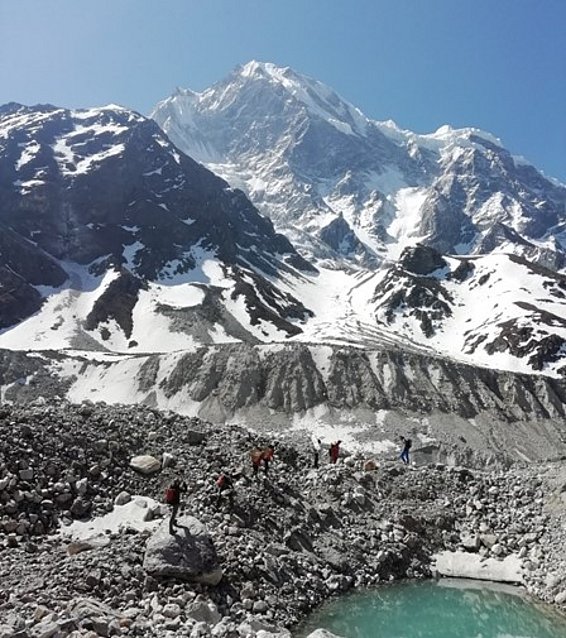RAVEN - Rapid mass loss of debris-covered glaciers in High-Mountain Asia
Francesca Pellicciotti
Vice Personale del progettoStefan Fugger
Marin Kneib
2018 - 2023
Cooperazione FinanziamentoHigh Mountain Asia (HMA) glaciers represent the largest mass of ice outside the Polar Regions and provide water resources for millions of people in the headwaters of the major Asian rivers. Nevertheless, their historical changes and future trends are unclear, due to a scarcity of direct observations and fundamental limitations in simulation models. Mantles of rock debris cover many glaciers across the spectrum of climate and morphological characteristics of HMA, and play a key role in modifying both glacier melt and dynamics. However, the controls of debris distribution, characteristics and dynamics are not clear, and debris has been observed to form on both the large, dynamically active semi-arid glaciers of the Karakoram and the smaller, stagnating glaciers of the monsoon-dominated central Himalaya. Despite debris-covered glaciers' vital importance, their role in catchment hydrology is poorly understood, as they have not been a focus of study until recent years.

RAVEN aims to provide a step-change in our understanding of the response of HMA glaciers to a warming climate by determining the role that debris-covered glaciers play in the water cycle of HMA and incorporating debris-covered glaciers into regional assessments of future runoff projections. It will establish the strength and regional extent of anomalous thinning patterns of debris-covered glaciers and bring this fundamental new understanding into models by integrating scales (from the point scale of single ponds and cliffs forming on the glacier surface to the scale of an entire glacier and then catchment) and methodological approaches (integrating numerical modelling and observational strategies).
The project is formulated as an in-depth catchment comparison to constrain the processes and rates of glacier melt in four study areas representing distinct climate zones along the Himalayan arc: the Karakoram (Shimshal catchment), Western and Eastern Himalaya (Alaknanda and Langtang catchments), and Tibetan Plateau (Parlung region). For each study area, we will leverage and expand upon existing hydro-meteorological networks; conduct novel, systematic field observations including GPS measurements, UAVs and time-lapse cameras; examine seasonal, annual, and decadal glacier changes using satellite imagery; and develop physically-based models for describing specific processes (e.g. cliffs and ponds energy balance). These diverse observations, spanning multiple scales, will be drawn together into the TOPKAPI-ETH glacio-hydrological model to understand current and future states for the catchments’ glaciers and hydrology.
Study area(s) ¶
- Satopanth Glacier, India: 30.757008° N, 79.370726° E
- Langtang Glacier, Nepal: 28.289739° N, 85.714407° E
- 24K Glacier, Tibet: 29.760768° N, 95.718322° E
- Virjerab Glacier, Pakistan: 36.309906° N, 75.605833° E
- European Research Council H2020-EU.1.1. Grant agreement 772751
Publications ¶
Buri, P. and F. Pellicciotti. 2018. Aspect controls the survival of ice cliffs on debris-covered glaciers, Proceedings of the National Academy of Science (PNAS), doi.org/10.1073/pnas.1713892115.
Ragettli, S., W. Immerzeel and F. Pellicciotti. 2016. Contrasting response to a warming climate of glacierised catchments in the Andes of Chile and Nepalese Himalaya, Proceedings of the National Academy of Science (PNAS), 113 (33), 9222–9227, dx.doi.org/10.1073/pnas.1606526113.
Buri, P., E. Miles, J. Steiner. W. Immerzeel, P. Wagnon and F. Pellicciotti. 2016. A Physically-Based 3D-Model of Ice Cliff Evolution over Debris-Covered Glaciers, Journal of Geophysical Research: Earth Surface, 121, dx.doi.org/10.1002/2016JF004039
Buri, P., F. Pellicciotti, J. Steiner, E. Miles, W. Immerzeel. 2016. A grid-based model of backwasting of supraglacial ice cliffs over debris-covered glaciers, Annals of Glaciology, 57 (71), 199-211, dx.doi.org/10.3189/2016AoG71A059.
Miles, E., F. Pellicciotti, I. Willis, J. Steiner, P. Buri, N. Arnold. 2016. Refined energy-balance modelling of a supraglacial pond, Langtang Khola, Nepal, Annals of Glaciology, 57(71) 2016 dx.doi.org/10.3189/2016AoG71A421.
Ragettli, S., F. Pellicciotti, W. Immerzeel, E. Miles, L. Petersen, M. Heynen, J. Shea, D. Stumm, S. Joshi, A. Shrestha. 2015. Unraveling the hydrology of a Himalayan watershed through systematic integration of high resolution in-situ ground data and remote sensing with an advanced simulation model, Advances in Water Resources, 78, 94-111, dx.doi.org/10.1016/j.advwatres.2015.01.013.
